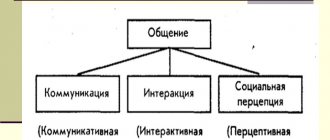The perceptual side of communication is the basis of interaction between people. How do you build communication? Are you always able to convey your point of view, gain the trust of your interlocutor, and create a desire to continue the dialogue? If not, perceptual mechanisms will help correct the situation. You will learn to see a person “through and through”, understand the motives of his actions, and correctly evaluate him as a person. Complete benefits. How to learn perceptual communication?
Perceptual side of communication
Communication as the exchange of information (communicative side of communication) Communication as interaction (interactive side of communication) Communication as people’s perception of each other (perceptual side of communication)
Social perception - people’s perception, understanding and assessment of social objects (other people, themselves, groups, social communities and so on.). The term social perception was introduced by the American psychologist J. Bruner.
It was found that the perception of social objects has a number of specific features that qualitatively distinguish it from the perception of inanimate objects. First, the social object (individual, group, etc.) is not passive and indifferent towards the perceiving subject, as is the case with the perception of inanimate objects. By influencing the subject of perception, the perceived person seeks to transform the idea of himself in a direction favorable to his goals.
Secondly, the attention of the subject of social perception is focused primarily not on the moments of image generation as a result of the reflection of perceived reality, but on semantic and evaluative interpretations of the object of perception, including causal ones (casual attribution)
Mechanisms of the perceptual side of communication:
Identification is an assumption about the inner world of a partner, based on an attempt to put oneself in his place.
Empathy is compassion, the empathy of a partner is an emotional response to the problems of another person, an understanding of the partner’s inner world.
Reflection - involves awareness of the individual, how he is perceived and understood by his partner. Stereotype - a simplified or distorted idea that a person develops under the influence of existing opinions in society.
Anthropological stereotypes are stereotypes of appearance.
Social stereotypes are professional and status-role assumptions about the psychological qualities of an individual.
Emotionally aesthetic stereotypes are judgments about psychological qualities based on physiological attractiveness.
Projection is a mechanism that manifests itself in the conscious or unconscious endowment of another person with qualities inherent in the subject himself.
Causal attribution is the attribution of causes. A mechanism for explaining the reasons for another person’s behavior based on one’s own observations.
Feedback in communication.
Communication cannot be reduced to simple transmission of information. In order to be successful, it necessarily involves feedback - the subject receiving information about the results of interaction
Individual features of a person’s physical appearance (face, arms, shoulders), postures, gestures, intonations act as carriers of information that should be taken into account when communicating. The face of the interlocutor or listener is a particularly informative carrier of feedback signals.
Often a fairly complete picture of the subject’s perception is given by his actions.
When interacting interpersonally, it is important to be open and sincere. A person interested in better understanding his relationships with others should be interested in the reactions of other people to his actions in specific situations, and take into account the true consequences of his behavior
Feedback is also a message to another person about how I perceive him, what I feel in connection with our relationship, how his behavior makes me feel. Giving and receiving feedback requires not only the skills, but also the courage.
Structure of communication in psychology
When communicating, the social relationship of people to each other is realized. During the exchange of information, each person is rooted as a full member of society. The concept of “communication” is a complex form of interaction, therefore, in order to understand its essence, it is necessary to study its components:
- communication;
- interaction;
- social perception.
The diagram shows that each part is responsible for one of the sides of communication.
Scheme
Functions and purpose
The functionality of perception includes knowing oneself and a partner, organizing joint actions, and establishing an emotional relationship.
Perceptual communication is based on three components: subject, object and the process of perception. Perception research is based on two components:
- content side (characteristic features of subjects, objects of perception);
- procedural part (analysis of the mechanisms and effects of perception).
The content part is the attribution of character traits, reasons for behavior, and role in communication to the object. The procedural side reveals the mechanisms of awareness and the effects of perception (novelty, primacy, stereotypes).
Perceptual component
This component allows you to correctly interpret the appearance and behavior of your interlocutor.
Based on the information received, a conclusion is drawn about the personality characteristics and reasons for actions.
Without perception, communications would be quite superficial and ineffective. A person would perceive only the “external picture” - the image of the opponent and his words.
Real thoughts, motives of behavior, hidden experiences and much more would escape attention. It is thanks to social perception that it becomes possible to accurately perceive surrounding objects and build effective interaction with them.
This component is fully manifested when a person is free from stereotypes, predetermined attitudes and beliefs. They interfere with an objective assessment of a partner and in advance form a certain image in the mind, which is often far from reality.
It is also important not to rush to a conclusion and give yourself time to form a reliable assessment. Often people make erroneous conclusions about the interlocutor with whom they communicated for a fairly short time
A person’s personality can be correctly assessed only by obtaining comprehensive information about him and observing him in different life situations.
The perceptual component allows you to change an already established opinion about an individual.
Sometimes people meet a person they knew well in the past and are surprised to discover significant changes in his character.
Such an opportunity to abandon the initial assessment that was formed earlier appears as a result of understanding and accepting those characteristics of the interlocutor that are observed in him at the current moment in time.
Aspects
Perception is a process that occurs when you first meet an individual. Based on the analysis of his external data, you are trying to understand what he is like inside. It is not for nothing that physiognomists say that there is a connection between the face and the psychological characteristics of a person.
The next stage of perception is the creation of emotional contact. It can be negative and positive. It all depends on the context of the conversation. To obtain complete information about a person, you need to pay attention not only to the external component and emotions. Behavior is also important.
Functions of social perception
Social perception is a complex process during which people understand and evaluate the social objects around them (people, groups, communities).
As a result of such a process, certain stable images are formed in the individual’s consciousness.
Briefly about the main functions of perception:
- Knowing yourself. Awareness of oneself through other objects. It is during social interaction that a person receives information about himself and food for thought. Often, the perception of the personality of the interlocutor helps to determine those inherent aspects of him that resonate in his own mind. As a result, a person reveals his hidden needs, desires, and doubts.
- Knowing your partner. You can get to know a person, understand his views and beliefs only through communication at the perceptual level. This is the only way to get reliable information about someone.
Gaining trust, establishing and effectively developing contact is possible only as a result of perceiving the opponent’s personality.Human activity is impossible without communication. Comradely, friendly, friendly, love relationships are impossible without communication.
Organization of joint activities. Understanding or acceptance by subjects of each other’s social relations is the basis for the further construction of joint activities. A clear understanding of the motives, attitudes and values of a partner allows you to develop a model of effective interaction with him. If we are talking not about the interaction of individuals with each other, but about relationships in a group, then the role of social perception only increases. The joint activities of group members become effective only when they are all able to accept or understand each other’s attitudes.
Building mutual understanding. In the process of communication, people achieve mutual understanding, which is the cementing factor of any social relationship (family, romantic, business, etc.).
Finding common points of interests, identifying common views and beliefs allows you to find a compromise and enjoy joint activities.
Establishing emotional relationships. Man is an emotional being, so any social interaction evokes certain emotions in him. When people come into contact, they form certain emotional relationships: sympathy, hostility, rejection, joy, etc.
Effects of Interpersonal Perception
There are 9 of them:
- The effect of primacy or order. This component of perception manifests itself when communicating with a stranger. Its essence is as follows: if the first impression left conflicting feelings, the image will be formed on the basis of previously received information.
- Edge effect. Objects of perception that are located at the edges are perceived better than those located in the center.
- The effect of novelty. In the case of a previously familiar person, new information about him plays a more important role in his perception.
- Halo effect. A brief explanation looks like this: new information about a person is superimposed on an already familiar image. The latter is the “halo”. It prevents you from perceiving your personality correctly. If you have a positive opinion about your interlocutor, then any information will lead to the same positive assessment. The same thing happens with negativity. Most often, this effect occurs when we are talking about moral principles.
- The effect of the first impression. Leads to the emergence of a stable opinion about a person. All subsequent estimates will not be consistent with reality.
- Projection effect. This is a state in which you attribute your advantages or disadvantages to your opponent. It all depends on your opinion of him.
- Average error effect. Deliberately downplaying the interlocutor's strong character traits.
- Barnum effect. A person perceives his characteristics as the most correct when they are confirmed by scientific, magical or ritual arguments.
- Boomerang effect. Its essence is that the information transmitted to the interlocutor causes an effect opposite to the expected one. This happens if you arouse hostility in your opponent or present false information. Another reason for the development of the effect is distrust of you.
Mechanisms of social perception
The perceptual side of communication includes several important tools that allow you to establish effective interpersonal interactions.
Reflection
This is the ability to analyze your actions, draw conclusions from what happened and see possible ways of developing the situation. In building communication, it is relevant at the moment when we are trying to visualize the impression we make on our opponent. The result may or may not meet expectations.
To reflect means to be able to look at the process from the outside, analyze what is happening and try to get to the essence of the problem through rational understanding.
Identification
Identifying oneself with the interlocutor, trying to put oneself in his place and look at the problem through the prism of his perception. This mechanism allows you to better understand and accept the speaker’s position.
Empathy
Represents the ability to empathize and sympathize. The more subtle a person’s mental organization is, the more developed his empathy is. Such people can analyze the internal state of their opponent simply by observing his behavior.
Anthropological, social and aesthetic stereotyping
An assessment of an individual's psychological characteristics is based on various stereotypes. Thus, many believe that deep-set eyes indicate toughness and secrecy, and weak hands indicate a lack of hard work.
Personal status, financial situation, and external attractiveness are also taken into account.
Attraction
An assessment of an individual that is based on a stable, long-lasting positive feeling towards a partner. It promotes the formation of closer interpersonal connections: friendship, love, affection.
Casual attribution
Interpretation of phrases and actions of the interlocutor based on personal assumptions and previous experience. This is an attempt to find out the reasons for this or that behavior, but not through observation and obtaining information, but based on one’s own prejudices and conclusions.
This is interesting: A letter to a loved one after a quarrel: a thorough look at the issue
First impression mistakes
Information enters the human consciousness from three sources:
- Visual perception, which forms a complex of visual images.
- An auditory source formed by a combination of sounds.
- The kinesthetic channel of management perception, built on sensations.
Important! Individual subjects of society are able to perceive and process data, focusing on three data sources. However, one channel is a priority; on its basis, the main perception, formation of thoughts, memories occurs
Modality (qualitative characteristics of sensations) in people (visual, auditory and kinesthetic, respectively) is formed individually.
Inequality
It arises against the background of a superior parameter that is subject to a positive assessment, or, conversely, if the subject is superior to the object of communication, the second is underestimated.
Attractiveness factor
An important factor is whether you like the appearance of the interlocutor. Under the influence of one factor, there is an overestimation or underestimation of the partner’s properties. With a positive perception of external parameters, there is a high probability of perceiving a person as an intelligent, interesting person.
Distorted perception of the interlocutor
Attitude factor
Social science says that people who have a kinder attitude seem better than those who have a bad attitude. Positivity generates a strong tendency to attribute positive qualities; as soon as the negative is included, the person will stop noticing the characteristic features of the partner and will begin to highlight the negative ones.
Errors in forming first impressions are called the halo effect, which is triggered by a number of reasons: prospect superiority, attractiveness and attitude.
The interactive side of communication
The interactive side of communication
consists in the regulation of behavior and the direct organization of joint activities of people in the process of their interaction. The concept of interaction is used in two ways: firstly, to characterize the actual real contacts of people (actions, counteractions, assistance) in the process of joint activity; secondly, to describe the mutual influences (impacts) on each other in the course of joint activities.
Interpersonal interaction
:
1) in a broad sense - accidental or intentional, private or public, long-term or short-term, verbal or non-verbal contact of two or more people, resulting in mutual changes in their behavior, activities, relationships and attitudes;
2) in a narrow sense - a system of mutually determined individual actions connected by a cyclical causal dependence, in which the behavior of each participant acts as both a stimulus and a reaction to the behavior of the others.
The structure of any interaction, according to N.V. Kazarinova, includes the following elements:
- roles of interaction participants;
- set and procedure;
- rules and regulations governing the interaction and nature of the relationships between participants.
Behavioral flexibility
— the presence of an assortment of ways to respond, the ability to choose a method of action. It gives you more opportunities to influence the situation.
Situations for using behavioral flexibility
:
- when planning an action – allows you to identify a number of possible approaches;
- when difficulties or factors arise that were not taken into account in advance;
- when a situation arises that other people have successfully dealt with, use their experience.
Perceptual side of communication
What is the perceptual side of communication?
Perception is a person’s reflection at the cognitive level of the objects and phenomena that he encounters.
The perceptual side of communication, from a psychological point of view, refers to the perception of another person, awareness of the characteristics of another person.
Perception of an opponent can occur through understanding his attitudes, goals, motives and views. In this case, an objective assessment of another person is formed, the properties of which do not overlap with the properties of the cognizing subject himself.
On the other hand, in the process of perceiving the interlocutor, not only his understanding, but also his acceptance can occur. In this case, all values and attitudes are shared and agreed upon by people.
When such acceptance occurs, close interpersonal relationships of various levels arise: affection, friendship, love, etc.
Using the perceptual side of communication, we “read” the other person. The success of communication with an individual depends on the degree of accuracy of the conclusions we come to. Incorrect identification of the interlocutor's identity can provoke misunderstanding and conflict.
Characteristics of the human interaction system
For diagnosis, psychologists use a holistic mechanism of communication elements, which, when establishing contact between one individual and another, are activated simultaneously.
These include:
- communication (transfer of information due to necessity or with a previously established connection);
- interaction (the moment of direct conversation between people, receiving emotions from each other);
- perception (the level of perception when an assessment of the situation occurs within one person, an understanding arises whether such communication will be useful and interesting for him at this stage of interaction).
These three parties create a system and are the main components of contact. If one of the functions is impaired or works with deviations, it becomes difficult or impossible to establish communication with the person.
He will not be able to convey information correctly or adequately perceive it, and there are also problems in conducting a conversation, building a dialogue, and expressing emotions.
additional literature
- Andreev, V.I.
Conflictology: the art of dispute, negotiation and conflict resolution / V. I. Andreev. – Kazan: SKAM, 1992. – P. 81-139.
- Bern, E.
Games People Play. Psychology of human relationships. You said hello. What's next? Psychology of human destiny / E. Bern. - Ekaterinburg: LITURE, 2005. - P. 7-53.
- Vardanyan, Yu. V.
Psychology of communication: textbook. allowance / Yu. V. Vardanyan, T. V. Savinova. – Saransk, 2003. – P. 15-29.
- Cornelius, H.
Everyone can win / H. Cornelius, S. Fair. – M.: Stringer, 1992. – P. 8-210.
- Rudensky, E.V.
Fundamentals of psychotechnology of manager communication / E.V. Rudensky. - M.: INFRA-M; Novosibirsk: NGAEiU, 1997. - P. 40-43.
Communication process model
There are several models of the communication process, the most famous of which is Harold Lasswell's concept.
This model originally included five elements, but Lasswell eventually added two more to it, changing the rest slightly. Original model:
- Who? (communicator, source of information, that is, the person who transmits information).
- What? (message sent by the communicator).
- On what channel? (method of transmitting information).
- To whom (recipient, recipient - this can be either one interlocutor or a whole audience).
- With what effect? (reaction to the message received, assessment of the effectiveness of communication).
Augmented model:
- Who? (communicator).
- With what intention? (Lasswell considered this question the most important, because without the motives and goals of communication it is impossible to talk about either channels or the target audience - that is, about communication in general).
- In what situation? (the situation can be of three types: favorable, neutral, unfavorable).
- With what resources? (resources should be understood as the communicator himself, as well as technologies, financial means and methods).
- Using what strategy? (Lasswell believed that every communicator should choose a strategy before speaking, and not just leave things to chance).
- For what audience? (if you know who your audience or interlocutor is, you can persuade them much more effectively).
How to learn effective communication?
There are many ways and tips to improve your communication skills, but we provide you with the most interesting and effective ones.
Always be aware of the context of what is happening. You need to understand what format your dialogue has:
- Social event.
- Formal contact at work or at home.
- Random episodic meeting.
- Asymmetrical situation (in training, leadership).
- A game.
- Relaxed informal dialogue.
Based on the context, it will be easier for you to choose the right behavior style.
Choose the right behavior style. Each situation dictates its own style of behavior and action. If you misread the context, communication will be difficult.
You have probably seen from the outside how ridiculous a person looks who behaves inappropriately in the context and how dozens of barriers are immediately erected between him and others.
It is believed that there are three styles of behavior: humanistic, manipulative and ritual.
Humanistic is a style that is aimed at mutual study of the ideas of partners, which leads to the emergence of empathy.
Manipulative - you are trying to instill your point of view in another person. It's just a tool that you can use for good or bad.
The ritual style is determined by a certain culture. In American society, it is customary to answer “Wonderful!” to the question “How are you?”
If you correctly understand the context of the situation, and also manage to choose the right behavior, you will significantly increase your chances that your message will be received as intended.
Use transactional analysis. Eric Berne in his book “Games People Play” presents his original view of transactional analysis - a direction that involves regulating the actions of interlocutors by regulating their positions. For Bern, these are the Parent (“I must!”), the Adult (“I want!” and “I must!”) and the Child (“I want!”).
You will communicate effectively with people if your positions coincide. For example, if a person approaches you in the role of an Adult, and you answer him in the same way. If there is a Parent-Adult or Parent-Child interaction, the goal of the conversation may not be achieved.
We wish you good luck!
Did you like the article? Join our communities on social networks or our Telegram channel and don’t miss the release of new useful materials: TelegramVKontakteFacebook
We also recommend reading:
- Storytelling
- 7 levels of communication according to A. B. Dobrovich
- Development of communication skills
- Social groups: signs, types, functions
- 6 Effective Communication Techniques
- Effective communication
- How to improve your listening skills
- The Cycle of Effective Communication
- Rules for effective online communications
- Nonverbal communication
- Conversation Techniques
Key words:1Profiling











